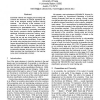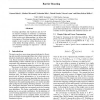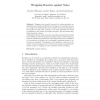IJCAI
2003
14 years 24 days ago
2003
Ensemble methods like bagging and boosting that combine the decisions of multiple hypotheses are some of the strongest existing machine learning methods. The diversity of the memb...
ACL
2006
14 years 25 days ago
2006
This paper proposes a semi-supervised boosting approach to improve statistical word alignment with limited labeled data and large amounts of unlabeled data. The proposed approach ...
NIPS
2007
14 years 26 days ago
2007
This paper studies boosting algorithms that make a single pass over a set of base classifiers. We first analyze a one-pass algorithm in the setting of boosting with diverse base...
SSPR
2000
Springer
14 years 3 months ago
2000
Springer
To improve weak classifiers bagging and boosting could be used. These techniques are based on combining classifiers. Usually, a simple majority vote or a weighted majority vote are...
PAKDD
2000
ACM
14 years 3 months ago
2000
ACM
Combining multiple global models (e.g. back-propagation based neural networks) is an effective technique for improving classification accuracy by reducing a variance through manipu...
CSB
2004
IEEE
14 years 3 months ago
2004
IEEE
Boosted PRIM (Patient Rule Induction Method) is a new algorithm developed for two-class classification problems. PRIM is a variation of those Tree-Based methods ( [4] Ch9.3), seek...
ASPLOS
1992
ACM
14 years 3 months ago
1992
ACM
The foremost goal of superscalar processor design is to increase performance through the exploitation of instruction-level parallelism (ILP). Previous studies have shown that spec...
FOCS
1999
IEEE
14 years 3 months ago
1999
IEEE
This paper connects two fundamental ideas from theoretical computer science: hard-core set construction, a type of hardness amplification from computational complexity, and boosti...
COLT
2000
Springer
14 years 3 months ago
2000
Springer
Boosting algorithms like AdaBoost and Arc-GV are iterative strategies to minimize a constrained objective function, equivalent to Barrier algorithms. Based on this new understandi...
AUSAI
2001
Springer
14 years 4 months ago
2001
Springer
Abstract. Wrappers have recently been used to obtain parameter optimizations for learning algorithms. In this paper we investigate the use of a wrapper for estimating the correct n...



